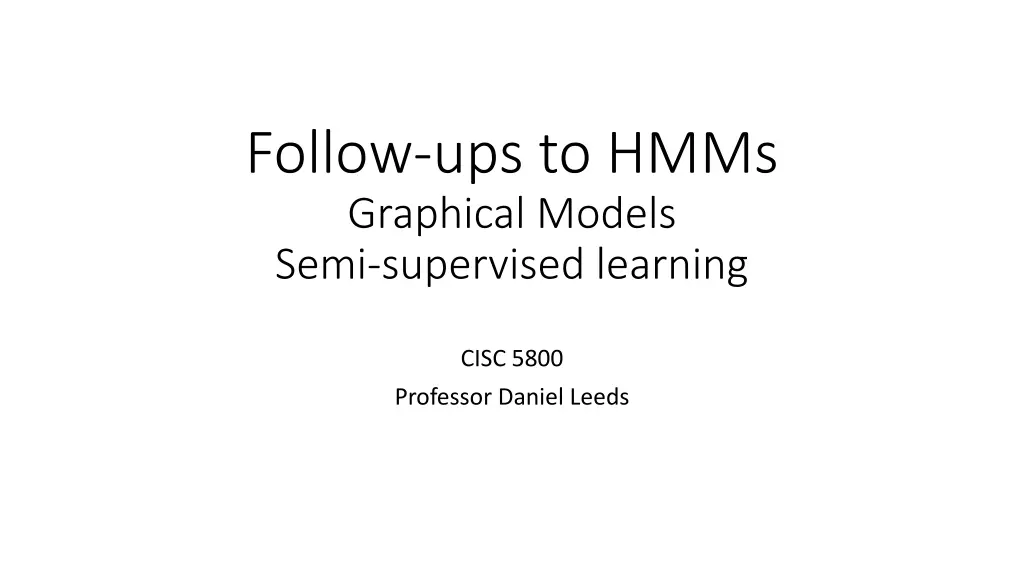
Learning Approaches in Graphical Models
Explore follow-up discussions on Hidden Markov Models (HMMs), graphical models, semi-supervised learning, conditional independence, and Bayesian networks, including examples and evaluations to understand the concepts better.
Download Presentation

Please find below an Image/Link to download the presentation.
The content on the website is provided AS IS for your information and personal use only. It may not be sold, licensed, or shared on other websites without obtaining consent from the author. If you encounter any issues during the download, it is possible that the publisher has removed the file from their server.
You are allowed to download the files provided on this website for personal or commercial use, subject to the condition that they are used lawfully. All files are the property of their respective owners.
The content on the website is provided AS IS for your information and personal use only. It may not be sold, licensed, or shared on other websites without obtaining consent from the author.
E N D
Presentation Transcript
Follow-ups to HMMs Graphical Models Semi-supervised learning CISC 5800 Professor Daniel Leeds
Approaches to learning/classification For classification, find highest probability class given features P(x1, ,xn|y=?) Approaches: Learn/use function(s) for probability P(rumble|Y=dog)=?(????,????) letter1 a P(letter1| word= duck ) 0.001 Learn/use probability look-up table for each combination of features: b 0.001 c 0.001 d 0.950 2
Joint probability over N features Problem with learning table with N features: If all dependent, exponential number of model parameters Burglar breaks in Alarm goes off Jill gets a call Zack gets a call P(A,J,Z|B) Na ve Bayes all independent Linear number of model parameters Y Y Y Y 0.3 Y Y Y N 0.03 Y Y N Y 0.03 Y Y N N 0.06 What if not all features are independent? 3
Bayes nets: conditional independence B Burglar E Earthquake A Alarm goes off J Jill is called Z Zack is called In Na ve Bayes: P(x1,x2,x3|y) = P(x1|y)P(x2|y)P(x3|y) In Bayes nets, some variables depend on other variables: P(B, E, A, J, Z) = P(B) P(E) P(A|B,E) P(J|A) P(Z|A) B E In general for Bayes nets: P(x1, ,xn) = ??(??|??(??)) A Pa(xi) are the parents of xi the variables xi is conditioned on J Z 4
Example evaluation of Bayes nets B Burglar E Earthquake A Alarm goes off J Jill is called Z Zack is called Use joint probabilities to find more probable variable value Compute P(E=yes|A,J,Z), P(E=no|A,J,Z) B E ??(?,?,?,?,?) ? ??(?,?,?,?,?) ? ? ?,?,? =?(?,?,?,?) ?(?,?,?)= A ?? ? ? ? ?(?|?,?)?(?|?)?(?|?) ? ?? ? ? ? ?(?|?,?)?(?|?)?(?|?) = J Z 5
Conditional independence B Burglar E Earthquake A Alarm goes off J Jill is called Z Zack is called If two variables xi and xjshare same parent, the xi and xj are independent given that parent J and Z are independent given A: J Z|A B E A J Z 6
HMM: a kind-of example of Bayes nets P(q1,q2,q3,o1,o2,o3) = q1 q2 q3 o1 o2 o3 7
Back to Expectation-Maximization Problem: Uncertain of yi (class), uncertain of ?? (parameters) Solution: Guess yi, deduce ??, re-compute yi, re-compute ?? etc. OR: Guess ??, deduce yi, re-compute ??, re-compute yi Will converge to a solution E step: Fill in expected values for missing variables M step: Regular MLE given known and filled-in variables Also useful when there are holes in your data 8
Types of learning Supervised: each training data point has known features and class label Most examples so far Unsupervised: each training data point has known features, but no class label ICA each component meant to describe subset of data points Semi-supervised: each train data point has known features, but only some have class labels Related to expectation maximization 9
Document classification example Two classes: {farm, zoo} 5 labeled zoo articles, 5 labeled jungle articles 100 unlabeled training articles Features: [% bat, % elephant, % monkey, % snake, % lion, %penguin] E.g., % bati = #{wordsInArticlei==bat}/#{wordsInArticlei} Logistic regression classifier 10
Iterative learning Learn w with labeled training data Use classifier to assign labels to originally unlabeled training data Learn w with known and newly-assigned labels Use classifier to re-assign labels to originally unlabeled training data Converges to a stable answer 11
